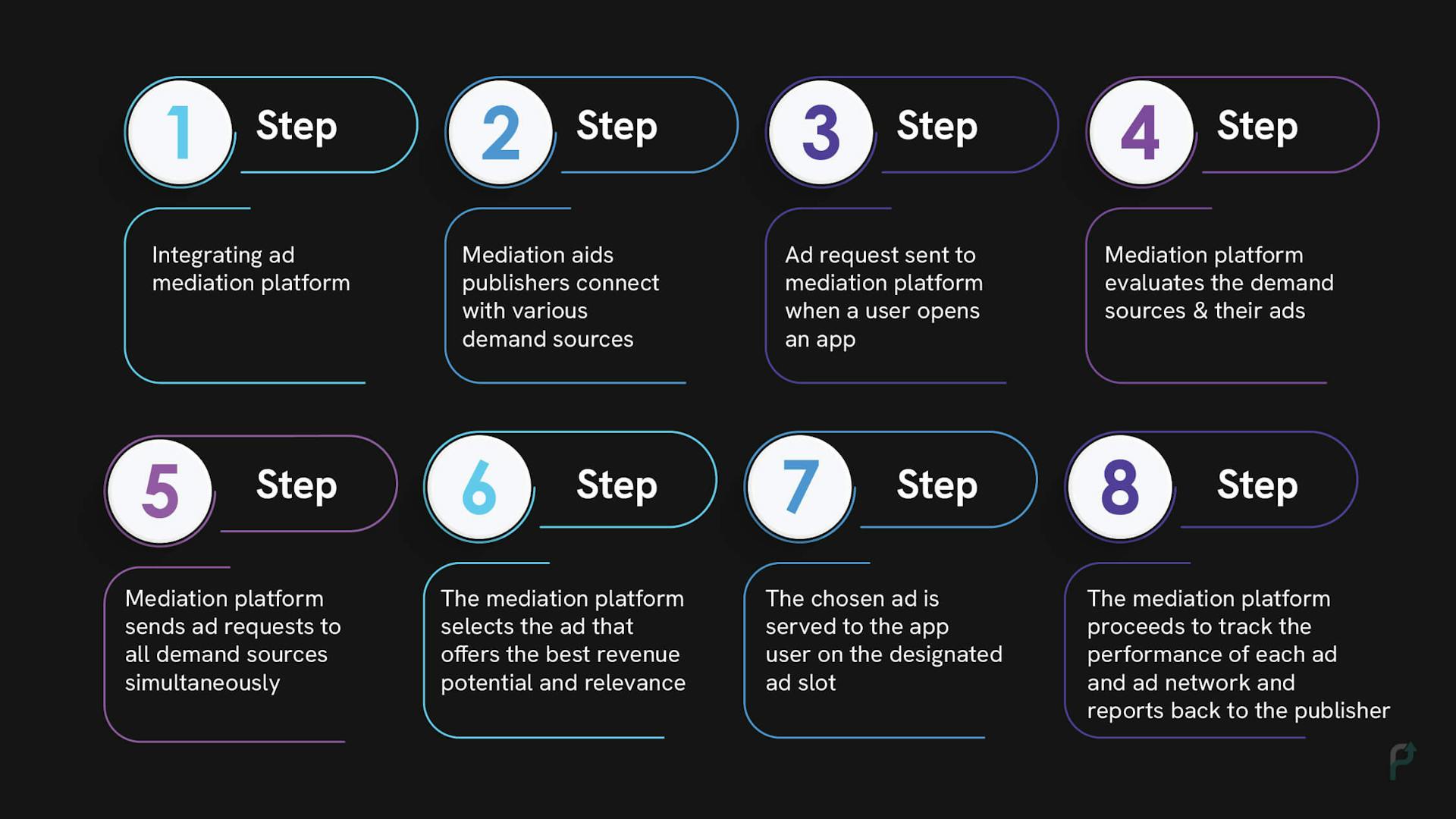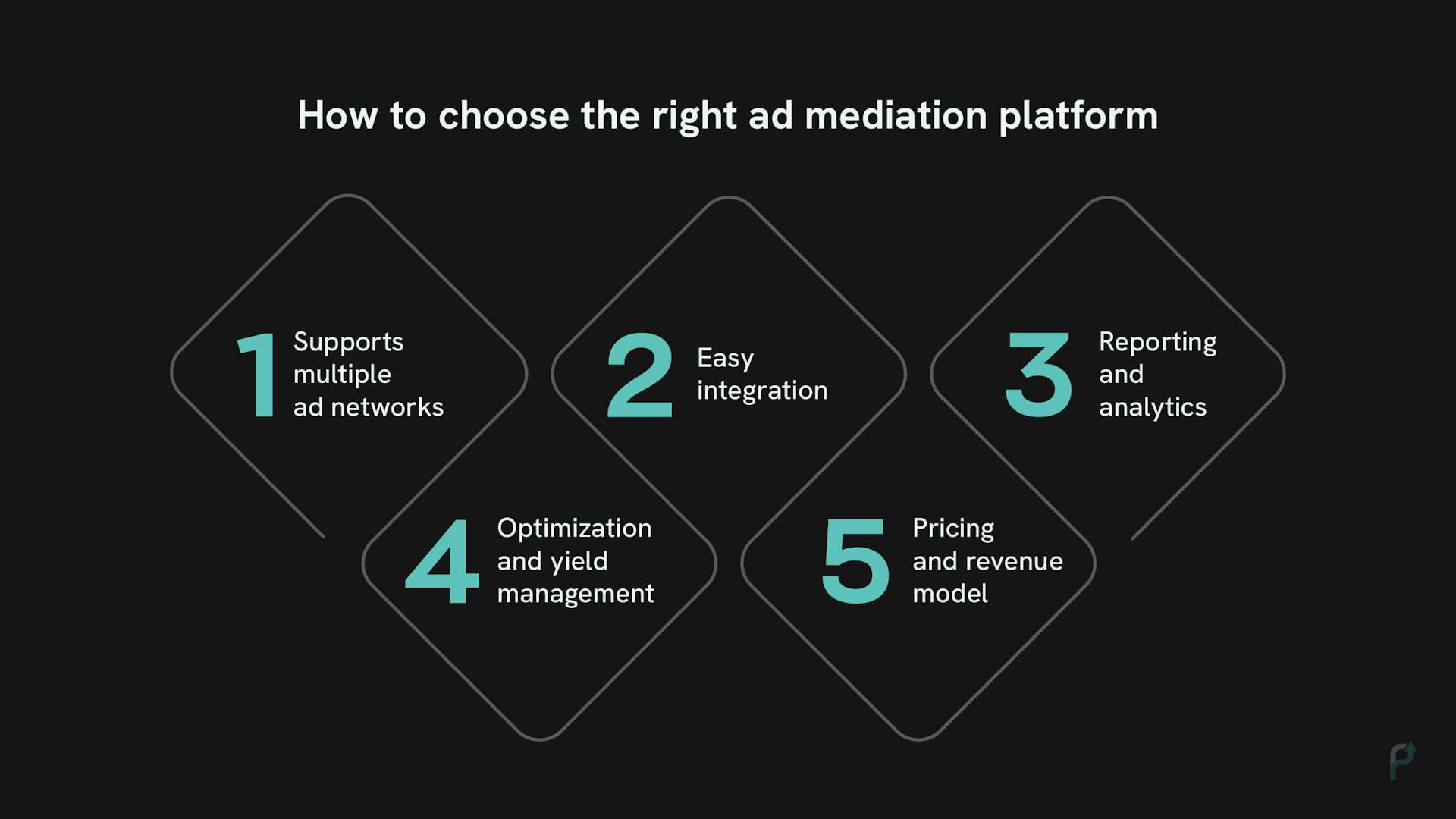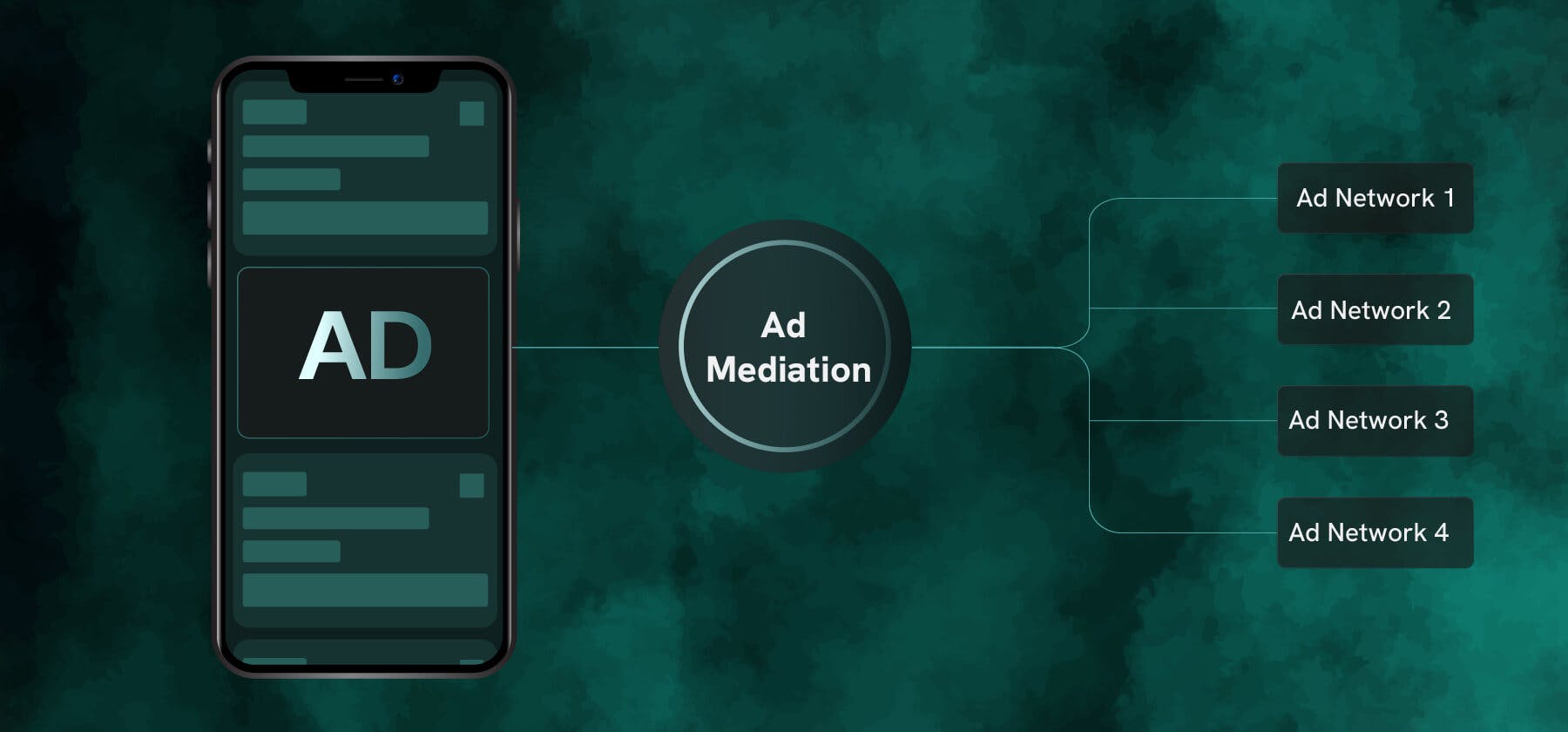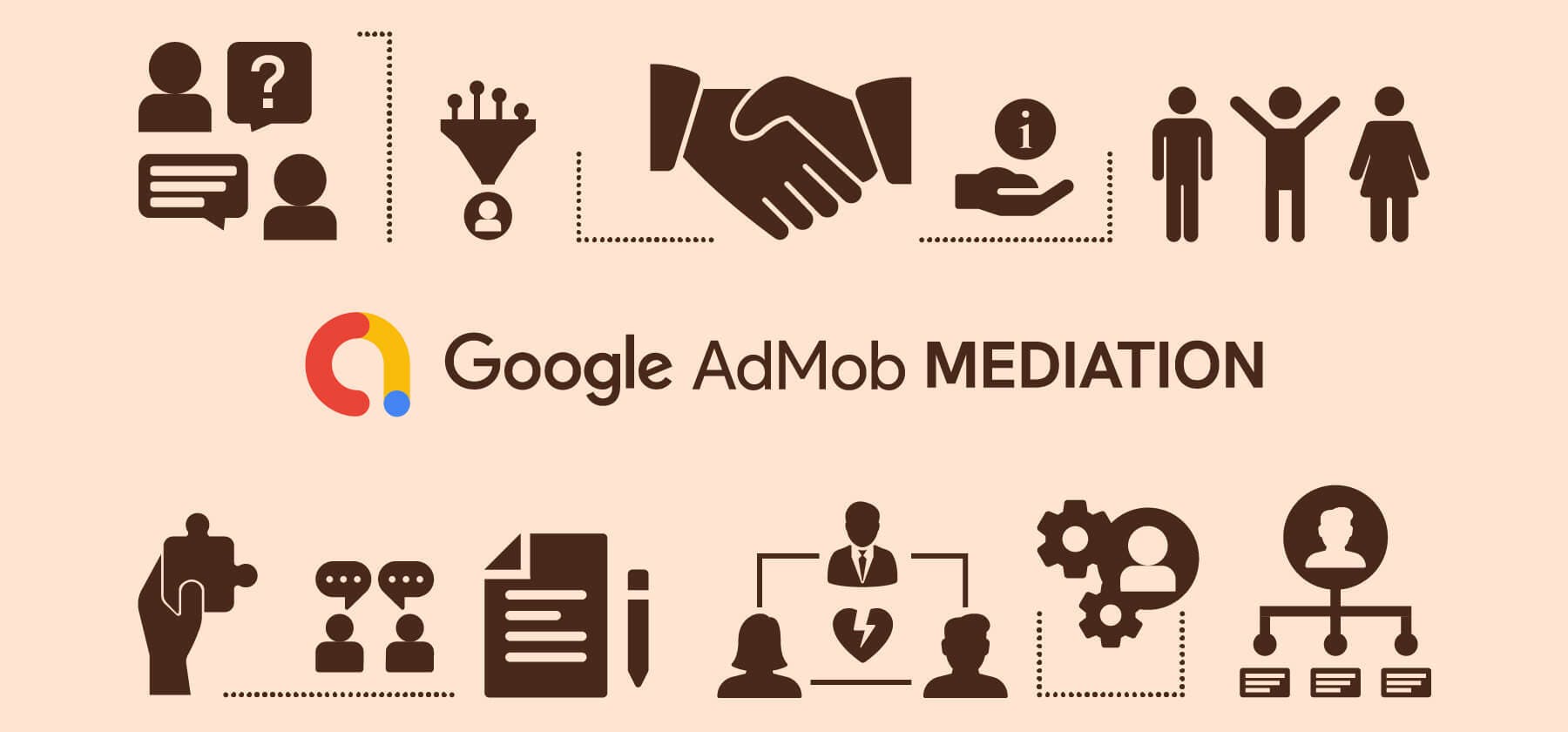- This guide on ad mediation platforms covers the basics of ad mediation platforms, their importance, and the bidding techniques employed by ad mediation platforms.
- This blog also explains the workflow of ad mediation platforms and touches upon the most popular mediation platforms in the market.
In today's dynamic digital landscape, publishers constantly seek ways to maximize and diversify their revenue streams. It is becoming increasingly complex for publishers to monetize their ad inventory efficiently. Amidst this, ad mediation platforms have stood out as indispensable tools for publishers to manage their ad inventories.
This article will unravel the basics of mobile ad mediation, how ad mediation platforms are effective monetization tools for publishers, and will shed light on some of the best ad mediation platforms.
What is ad mediation
Mobile ad mediation is a process that allows publishers to optimize their ad inventory and manage multiple ad networks on a single platform. So, ad mediation tools act as a mediator between publishers and ad networks. They aid a publisher in maximizing their revenue by leveraging competition between various ad networks.
Mobile ad mediation platforms combine technology, data, and demand sources to streamline a publisher's monetization efforts, optimize ad inventory and achieve high eCPMs.
We will learn how ad mediation platforms work later in this article.
Experience Higher CPMs and Fill Rates - Switch to Ad Mediation.
Ad mediation techniques
The predominant function of ad mediation is to help publishers scale their revenue. Ad mediation tools connect to multiple demand sources and select an ad through bidding. Ad mediation employs one of the two types of bidding.
Waterfall method
The waterfall is the more traditional of the two options for ad mediation. The mediation platform follows a sequential order while approaching the demand sources in this method. The mediation platform sends ad requests when users visit an app or webpage. The ad request is sent to the highest-priority demand source. Suppose the demand source returns the ad with a bid response; then, this ad is served to the user.
The bidding process continues if the first demand source fails to give a bid response. The ad request is sent to the demand source that is considered second best. This process is continued until a suitable ad from the right demand source is received. The waterfall method involves approaching all demand partners sequentially till it exhausts all demand sources.
The most noteworthy characteristic of waterfall bidding is its sequential nature. Here, demand sources are accessed in a predetermined order. This method studies historical performance and metrics like eCPM before determining which demand source should be prioritized.
However, waterfall mediation has three main drawbacks. They are as follows.
- Latency Issues
- Over-reliance on historical data
- Limited Competition
-
Latency issues: Setting up waterfall mediation is a difficult task that can be done only manually. It increases the time it takes for an ad inventory to approach a demand source. Publishers might miss out on revenue and efficiency.
-
Over-reliance on historical data: This results in a limited revenue yield. Since publishers often undersell their inventory, a low-ranking ad network willing to bid higher is taken out of the competition. This happens when a higher-ranking bid wins.
-
Limited competition: Publishers can access only one demand source at a time. So this makes the bidding narrow and less frequent.
Header bidding
Header bidding is a relatively recent and advanced method that mobile ad mediation tools use to increase competition among demand sources. Unlike waterfall bidding, which follows a sequential process, header bidding opts for simultaneous and parallel bidding. It helps access multiple demand sources at the same time.
The ad network mediation sends multiple ad requests to multiple demand sources simultaneously, typically using a header bidding wrapper. Each demand source evaluates the ad request and responds with bids within a specific time window. The mediation collects these bid responses, selects the highest bidder, and displays their ad. This method enables demand sources to compete in real-time and ensures that the highest-paying, relevant ad is served.
Header bidding has a considerable edge over the waterfall method since it is transparent. All demand sources have equal opportunities to participate in the auction. It maximizes revenue potential by giving scope for competition. Header bidding allows publishers to gain insights into bid data, helping them make informed decisions about their ad inventory.
Header bidding also has some drawbacks on the client side. They are as follows.
- Latency issues
- Browser compatibility
-
Latency issues: Header bidding surpasses waterfall regarding pass-backs but has minor issues with page load time and latency. Adding more scripts can slow the page-load time and negatively impact user experience.
-
Browser compatibility: Client-side header bidding must be compatible with different browsers. If it is not, it might compromise efficiency.
Interested to know more about Header Bidding? Read our Header Bidding Guide.
Hybrid bidding model
The hybrid model integrates header bidding and waterfall methods to optimize the mediation process. When an ad request is received, the hybrid bidding model initiates header bidding. Multiple demand sources, such as ad exchanges or DSPs, are invited to submit bids for the ad inventory in real-time. The bids received from the header bidding stage are evaluated, and the highest bid wins the auction. The winning bid is selected, and its corresponding creative is chosen to be served to the user.
If the header bidding stage does not result in a successful bid or if there are additional ad slots to be filled. Here is where the waterfall method comes into play. In the waterfall stage, each demand source is evaluated one after another based on a predefined priority order. The ad is served if the demand source has an ad available and meets specific criteria.
The hybrid bidding model dynamically determines whether to continue the waterfall process or stop after a successful ad fill.
Importance of mobile ad mediation
A mobile ad mediation platform is predominantly used to increase publishers' ad revenue. Ad mediation encourages multiple ad networks to access a publisher’s inventory and compete against each other for the ad slots, in turn, helps increase the publisher’s ad revenue.
An ad mediation platform usually has a reporting database that checks the CPM offered by various demand sources. It chooses the demand partner offering the highest CPM and takes it to the publisher. Some ad mediation platforms also have auto-optimization algorithms that can increase performance and helps save time and resources for the publisher.
Furthermore, ad mediation tools can consolidate many ad networks into one SDK integration, preventing the need for an individual SDK for each demand partner. This will help make the process efficient, save time, and do away with any unforeseen irregularities an app user might experience.
We recently conducted a webinar on maximizing revenue where we discussed about how ad mediation can help publishers. The webinar covered concepts like-
- How ad mediation helps increase app earnings
- The workflow of header bidding
- The workflow of the waterfall method
If you are interested to know how to get started with ad mediation and monetize your app, then feel free to watch the free webinar- Unleashing App Revenue Potential: Expert Tips and Tricks.
It is imperative to note that ad mediation is predominantly leveraged for mobile apps. But websites can also use ad mediation. The SDK that apps use, in the case of websites, refers to Javascript codes, AMP codes, or wrapper codes.
How do ad network mediation platforms work
 How do ad network mediation platforms work
How do ad network mediation platforms workThere is a multi-step process involved in getting an ad mediation platform to choose the best ad network and optimize the bidding process. It is as follows.
-
Step-1: The publisher will first integrate the ad mediation platform into their software development kit (SDK). The SDK will provide the tools and functionalities required to communicate with the ad mediation platform.
-
Step-2: The ad mediation platform helps the publisher connect with various ad networks, demand-side platforms (DSPs), and other demand sources. The publisher can connect with the desired ad network by providing their account credentials.
-
Step-3: When a mobile or website user opens the app or webpage, an ad request is sent to the ad mediation platform. This request will contain information like the user's device type, location, and more.
-
Step-4: The ad network mediation receives these ad requests and evaluates the ad networks and demand sources it is connected to. The ad mediation platform considers eCPM, fill rates, historic performance, targeting options, etc.
-
Step-5: The mobile ad mediation sends the ad request to all the ad networks simultaneously. The ad networks and demand sources respond to the ads with bids for the impression.
-
Step-6: Based on the publisher's requirements, it can act as a ad revenue optimization platform. It compares the bids and selects the ad that offers the best combination of revenue potential and relevancy. Thus, it optimizes your ad revenue effectively.
-
Step-7: The chosen is served to the app user in milliseconds. The ad appears on the designated ad placement since the ad mediation platform provides the necessary instructions and assets to display the ad.
-
Step-8: The work of an ad mediation platform does not end here. The platform starts to track and record the performance of each ad network and its ads. This data will inform publishers to optimize their monetization strategy. The ad network mediation platform provides comprehensive reporting and analytics tools that allow publishers to monitor ad performance, revenue trends, user engagement, and more.
Based on the performance data provided by the ad network mediation platform, publishers can adjust their ad mediation strategies, prioritize ad networks, and experiment with different ad combinations to derive the best strategy for them.
Fill your unfilled inventories with ad mediation today.
How to choose the right mobile ad mediation platform
A publisher must factor in multiple criteria while choosing the right ad mediation platform. The criteria are as follows.
- Support multiple ad networks
- Easy integration
- Optimization and yield management
- Reporting and analytics
- Pricing and revenue models
-
Supports multiple ad networks
A publisher must look for an ad mediation platform that supports a broad range of ad networks. The chances of maximizing the publisher's revenue are higher if the mediation platform supports numerous ad networks.
-
Easy integration
A publisher must ensure their ad mediation platform is easily integrated with their app or website. So platforms that offer a viable SDK and user-friendly tools must be looked for.
-
Optimization and yield management
An effective mobile ad mediation tool must offer robust optimization features with intelligent algorithms, A/B testing abilities, and real-time reporting to help optimize ad placements.
 Mobile Ad Mediation Platforms Eligibility
Mobile Ad Mediation Platforms Eligibility -
Reporting and analytics
It is vital to have detailed analytics to understand ad performance. So publishers must choose an ad network mediation tool that offers comprehensive reporting on metrics like clicks, revenue, eCPM, and user engagement. Accessing real-time data will help publishers make data-driven decisions.
-
Pricing and revenue model
Publishers must understand the pricing structure and revenue-sharing model of the ad mediation platform they opt for. Some platforms offer freemium features, while some might charge a part of the revenue as a fee.
5 best ad mediation platforms
There are many ad mediation platforms publishers can leverage to maximize their ad revenue. Some of the top ad mediation platforms are as follows.
- PubScale
- Google AdMob
- ironSource
- Unity
- AppLovin
-
PubScale
PubScale is a one-stop app growth platform with an SDK that can seamlessly integrate with publishers’ apps or websites. PubScale's SDK X integration process is similar to AdMob, ensuring that most publishers are familiar with it, resulting in a hassle-free integration. This ad mediation platform uses bidding techniques like a waterfall and smart waterfall to ensure high eCPM and, in turn, increased ad revenue.
-
Google AdMob
Google AdMob, one of the best mobile ad mediation networks, can integrate with over 30 top ad networks and over 97 percent of AdAge's top 100 advertisers. It also enables automatic audience segmentation and other automated tasks that save publishers much time. Google AdMob Mediation also has a dedicated guidance setup for particular apps.
Learn how to integrate AdMob with PubScale and start with AdMob Mediation.
-
ironSource
ironSource is a top ad mediation platform to increase app revenue and eCPM. This platform has 15 ad networks publishers can choose from. ironSource supports various ad formats like rewarded video, Offerwall, interstitial, and banner ads. With its simple dashboard, user-friendly interface, and different mediation models, this ad mediation platform has simplified the revenue-making process for publishers.
-
Unity
Unity has its stand-alone mediation product called Unity Ads Mediation. By driving more competition for the publishers' inventory, this top mobile ad mediation network can help them maximize their revenue potential. It offers both in-app bidding and waterfall bidding. Publishers can track their eCPM, revenue, fill rates, and impressions in one dashboard. This makes it easy to optimize the waterfalls for the best campaign.
-
AppLovin
AppLovin's MAX is a robust ad network mediation platform that can manage numerous ad networks, optimize ad placements and create better results for publishers. It has stellar targeting capabilities and enables publishers to send gain access to highly relevant ads based on user interest. It also helps track the efficiency of publishers' campaigns with its reporting and analytics tools.
Key Takeaways
Having the right ad mediation platform as part of one’s monetization strategy is essential for all publishers. To stay ahead of the curve in today’s competitive digital advertising landscape, publishers must research and choose the best ad mediation platform. By carefully evaluating factors like analytics, monetization control, reliability, and pricing structure, publishers must choose a platform that aligns with their requirements and goals.
We hope you found this blog informative. Keep checking in because we’re bringing you more such content!
Frequently Asked Questions
The only ad platform built for developers by developers.
Contact us now for a product that fits your needs! It’s quick, simple and easy.



